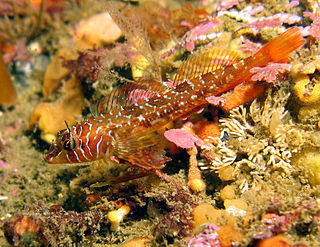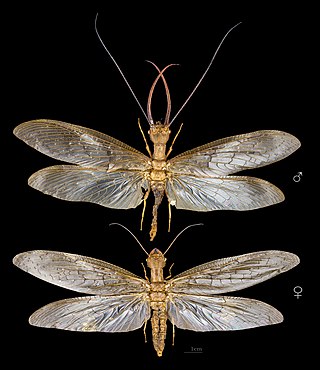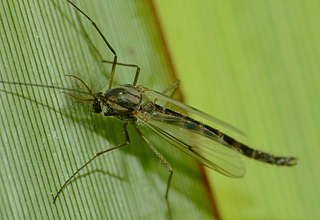Related Research Articles

Metamorphosis is a biological process by which an animal physically develops including birth transformation or hatching, involving a conspicuous and relatively abrupt change in the animal's body structure through cell growth and differentiation. Some insects, jellyfish, fish, amphibians, mollusks, crustaceans, cnidarians, echinoderms, and tunicates undergo metamorphosis, which is often accompanied by a change of nutrition source or behavior. Animals can be divided into species that undergo complete metamorphosis ("holometaboly"), incomplete metamorphosis ("hemimetaboly"), or no metamorphosis ("ametaboly").

A gill is a respiratory organ that many aquatic organisms use to extract dissolved oxygen from water and to excrete carbon dioxide. The gills of some species, such as hermit crabs, have adapted to allow respiration on land provided they are kept moist. The microscopic structure of a gill presents a large surface area to the external environment. Branchia is the zoologists' name for gills.

Mayflies are aquatic insects belonging to the order Ephemeroptera. This order is part of an ancient group of insects termed the Palaeoptera, which also contains dragonflies and damselflies. Over 3,000 species of mayfly are known worldwide, grouped into over 400 genera in 42 families.

An aquatic animal is any animal, whether vertebrate or invertebrate, that lives in water for all or most of its lifetime. Many insects such as mosquitoes, mayflies, dragonflies and caddisflies have aquatic larvae, with winged adults. Aquatic animals may breathe air or extract oxygen from water through specialised organs called gills, or directly through the skin. Natural environments and the animals that live in them can be categorized as aquatic (water) or terrestrial (land). This designation is polyphyletic.

Aquatic respiration is the process whereby an aquatic organism exchanges respiratory gases with water, obtaining oxygen from oxygen dissolved in water and excreting carbon dioxide and some other metabolic waste products into the water.
Aquatic insects or water insects live some portion of their life cycle in the water. They feed in the same ways as other insects. Some diving insects, such as predatory diving beetles, can hunt for food underwater where land-living insects cannot compete.

A water beetle is a generalized name for any beetle that is adapted to living in water at any point in its life cycle. Most water beetles can only live in fresh water, with a few marine species that live in the intertidal zone or littoral zone. There are approximately 2000 species of true water beetles native to lands throughout the world.

The Haliplidae are a family of water beetles that swim using an alternating motion of the legs. They are therefore clumsy in water, and prefer to get around by crawling. The family consists of about 200 species in 5 genera, distributed wherever there is freshwater habitat; it is the only extant member of superfamily Haliploidea. They are also known as crawling water beetles or haliplids.

Protopterus is the genus of four species of lungfish found in Africa. Protopterus is considered the sole genus in the family Protopteridae, which is grouped with Lepidosiren in the order Lepidosireniformes.

Megaloptera is an order of insects. It contains the alderflies, dobsonflies and fishflies, and there are about 300 known species.

The caddisflies, or order Trichoptera, are a group of insects with aquatic larvae and terrestrial adults. There are approximately 14,500 described species, most of which can be divided into the suborders Integripalpia and Annulipalpia on the basis of the adult mouthparts. Integripalpian larvae construct a portable casing to protect themselves as they move around looking for food, while annulipalpian larvae make themselves a fixed retreat in which they remain, waiting for food to come to them. The affinities of the small third suborder Spicipalpia are unclear, and molecular analysis suggests it may not be monophyletic. Also called sedge-flies or rail-flies, the adults are small moth-like insects with two pairs of hairy membranous wings. They are closely related to the Lepidoptera which have scales on their wings; the two orders together form the superorder Amphiesmenoptera.

Dobsonflies are a subfamily of insects, Corydalinae, part of the Megalopteran family Corydalidae. The larvae are aquatic, living in streams, and the adults are often found along streams as well. The nine genera of dobsonflies are distributed in the Americas, Asia, and South Africa.

The eastern dobsonfly, Corydalus cornutus, is a large insect in the Corydalidae family. It is found in eastern North America in regions with fast-flowing streams where its aquatic larvae develop. These are known as hellgrammites and are among the top invertebrate predators in the streams in which they live. They are used by anglers as bait.

Ceratopogonidae is a family of flies commonly known as no-see-ums, or biting midges, generally 1–3 millimetres in length. The family includes more than 5,000 species, distributed worldwide, apart from the Antarctic and the Arctic.

Byrrhoidea is a superfamily of beetles belonging to Elateriformia that includes several families which are either aquatic or associated with a semi-aquatic habitat. Other than the superfamily Hydrophiloidea, most of the remaining Polyphagan beetles which are aquatic are in this superfamily.

The Culicinae are the most extensive subfamily of mosquitoes (Culicidae) and have species in every continent except Antarctica, but are highly concentrated in tropical areas. Mosquitoes are best known as parasites to many vertebrate animals and vectors for disease. They are holometabolous insects, and most species lay their eggs in stagnant water, to benefit their aquatic larval stage.

Water-penny beetles are a family of 272 species of aquatic beetles found on all continents except Antarctica, in both tropical and temperate areas. The young, which live in water, resemble tiny pennies. The larvae feed – usually nocturnally – on algae on rock surfaces. The presence of water-penny larvae in a stream can be used as a test for the quality of the water, as they are pollution-sensitive. They cannot live in habitats where rocks acquire a thick layer of algae, fungi, or inorganic sediment. Therefore, their presence along with other diverse phyla signifies good-quality water. They are around 6 to 10 millimeters in length.

The coastal giant salamander is a species of salamander in the family Dicamptodontidae. It is endemic to the Pacific Northwest of North America. There are three closely related species to this taxon: D. ensatus, D. copei, and D. aterrimus.

A gnat is any of many species of tiny flying insects in the dipterid suborder Nematocera, especially those in the families Mycetophilidae, Anisopodidae and Sciaridae. Most often they fly in large numbers, called clouds. "Gnat" is a loose descriptive category rather than a phylogenetic or other technical term, so there is no scientific consensus on what constitutes a gnat. Some entomologists consider only non-biting flies to be gnats. Certain universities and institutes also distinguish eye gnats: the Smithsonian Institution describes them as "non-biting flies, no bigger than a few grains of salt, ... attracted to fluids secreted by your eyes".

Chironomus zealandicus, commonly known as the New Zealand midge, common midge, or non-biting midge, is an insect of the Chironomidae family that is endemic to New Zealand. The worm-like larvae are known to fisherman and have a common name of blood worm due to their red color and elongated blood gills.
References
- 1 2 Thorpe, W. H. (April 1933). "Tracheal and Blood Gills in Aquatic Insect Larvæ". Nature. 131 (3311): 549–550. doi:10.1038/131549b0. ISSN 1476-4687.
- ↑ "Definition of BLOOD GILL". www.merriam-webster.com. Retrieved 2019-10-18.